| Article ID | Journal | Published Year | Pages | File Type |
|---|---|---|---|---|
| 10286210 | Energy and Buildings | 2005 | 5 Pages |
Abstract
A further validation of an earlier developed neural network method for estimating the total heat loss coefficient (Ktot), the total heat capacity (Ctot) and the gain factor (α) based on measured diurnal data of internal-external temperature difference, supplied heat for heating and “free heat” is presented. The validation was performed in laboratory scale, using a test cell, for three different cases of ventilation, without (constant)-, natural-, and forced ventilation. Earlier measurements from a building was also used in order to simulate a realistic energy use pattern and a rather stochastic behavior of α, which also was transformed to represent existing and future buildings in terms of the composition of their energy use. For all three types of ventilation and different types of buildings, the method was capable of estimating the three different performance parameters and their different dependencies. For Ktot, the RMSE was between 3 and 20% and for α, the deviation was between 9 and 19%.
Keywords
Related Topics
Physical Sciences and Engineering
Energy
Renewable Energy, Sustainability and the Environment
Authors
Mikael Lundin, Staffan Andersson, Ronny Ãstin,
